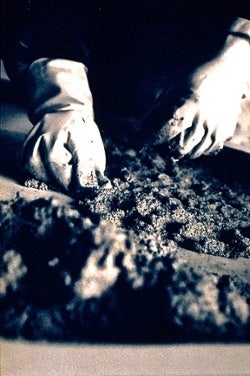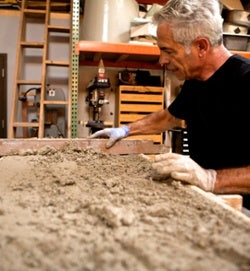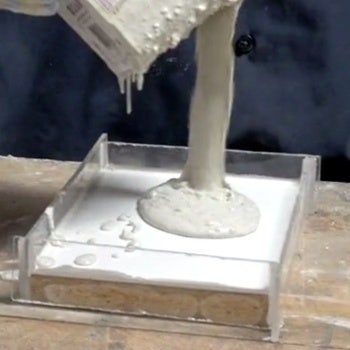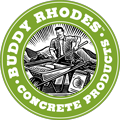Craftsman Mix | The Ultimate Concrete Countertop Mix, Part 3
Craftsman Mix- Recipes
The Craftsman Mix has all of the ingredients blended in that will stay consistent regardless of the circumstances. All of the sands and aggregates, cement, pozzolans, curing polymers, and chemical admixtures necessary to create a durable mix are in the bag. What's not in the mix are the materials needed to custom build your mix for the application you are using. We start with a stiff white base; from there you can add pigments, water reducers, fibers, and additional aggregates to suit your fancy. Combine these chosen ingredients with a specified amount of water, and Bam! you have a mix to suit most any circumstance.

Mixing Instructions
- Set aside +/- 30% of your dry mix.
- Add water and water reducer to 70% of your dry ingredients and mix until fully blended.
- After initial blending, add any pigments you are using. Blend until homogeneous.
- Slowly add the remaining dry ingredients into the mix. Blend until homogeneous.
- For Backer Mixes- Slowly add the AR Glass Fiber, blend until homogeneous. Temper with Water Reducer as needed for desired consistency.
*Overmixing of the glass fiber can cause the fiber to break down. Do not mix glass fiber longer than 2 minutes. It is best only to mix as long as necessary for the fiber bundles to disperse through the mix.
General Notes
This mix is typically cast at 1.25” - 1.5” thick. It can be cast thinner, particularly with the use of AR Glass Fibers in the backer mix, but consideration must be given in the handling and support of the piece. Tiles and other objects that are smaller in overall dimension can be poured much thinner, down to 1/2" if proper consideration is given.
Coverage- One bag covers +/- 5 sq. ft. at 1” thick.
Cement Content- 20.5 lb per bag
Press Recipe

The Press Technique is Buddy Rhodes’ signature technique. It is achieved by using his Craftsman Mix with as little water as possible to create a dry, clay like mix. This mix is then hand packed into the mold; because the mix is so dry, during placement there are a lot of voids that naturally occur creating a veined look. This is what we want; that beautiful structural geology.
In many cases, the pressed technique is approached in a similar manner to the composition of GFRC. A thin layer is pressed into the form (Face Mix), followed by a structural mix containing AR Glass Fiber (Backer Mix), offering the piece the necessary structural reinforcement.
Because this mix is often pressed up vertical walls, it is important to be cautious with dosing water reducer. If too much water reducer is added, the mix will have a tendency to slump down your vertical surfaces. Water reducer should only be used sparingly in the surface mix to soften the mix for improved workability. You can be slightly more liberal when adding water reducer to the backer mix to compensate for the glass fiber stiffening the mix.
The AC50 Acrylic Fibers can be a good addition in the face mix to give more body for pressing up vertical walls. It will also provide additional stability in the finished concrete, reducing issues of shrinkage, impact, and abrasion.
50 lb Craftsman Mix
6.8 lb Chilled Water
0-5 ml Water Reducer 444
20 Grams- AC50 Acrylic Fiber (Optional)
1.25- 1.5 lb Alkali Resistant Glass Fiber (Backer Mix Only)
This recipe is ideal for the Pressed Technique, which is the most user friendly casting process in the world of artisan concrete. This same recipe can be used for sculptural castings, or other castings that require a mix that does not slump and is easily shapable. You will be hard pressed to find a more enjoyable mix for casting.
Cast In Place Recipe

The trowel technique is different in that you are building your forms right side up; either in the shop or actually cast in place at the job site. This technique is a great opportunity to show the unique hand and skill of the craftsman. The final finish has an almost buttery, leathery look and feel due to the trowel work bringing up the cream and working it at different stages of curing.
Cast in place objects can also be composed with a structural mix containing fibers which is placed in the forms first, followed by a face mix that only contains the AC50 Acrylic Fibers. If additional reinforcement is needed, we would recommend layers of glass scrim. You can opt to use steel as a means to reinforce, but note that rebar should not be used with these mixes. The maximum sized steel that should be used is 9 ga. ladder wire.
This mix contains additional aggregate in order to improve yield and reduce shrinkage. The mix that is added at the surface (the layer that you trowel) can be made without fiber to improve trowelability. The aggregate is ideal for cast in place mixes, but should be left out of mixes that are precast and troweled.
You can use water reducer to taste in this application. A stiffer mix will be ready for troweling sooner, the addition of water reducer will produce a more fluid mix that will be a touch more difficult to trowel initially but will consolidate along the edges more efficiently, leaving fewer air voids along the edge.
50 lb Craftsman Mix
15 lb 3/8” Aggregate (can be withheld in the troweling layer | not intended for precast applications)
6.8 lb Chilled Water
Water Reducer 444 to taste
20 Grams AC50 Acrylic Fiber (recommended, particularly in the troweled surface)
1.25- 1.5 lb Alkali Resistant Glass Fiber (Backer Mix Only)
This recipe is ideal for troweled surfaces, particularly countertops that are being cast in place. There are aspects of the cast in place process which are simpler, and other aspects that are more difficult than precast methods. The biggest consideration is that the concrete is going to get hard whether you like it or not, and that will be your finished surface. Practice with a trowel on test pieces is recommended. Following casting, the concrete can be polished to expose aggregates or smooth the surface.
Pourable Recipe

The casting technique (Pour and vibrate) is fairly straight forward. Build a watertight mold and pour in the concrete. If mixed properly and vibrated well, a good clean surface can be achieved free of any air pockets or bug holes. For an aesthetic that includes pits and holes, minimize your water reducer and/or vibration.
This is the most common method for casting concrete. Make it fluid, pour it in. Despite the fact that the Craftsman Mix is known for the ability to behave like clay, this mix is easily made into a fluid mix.
If you are pouring into vertical forms, don't make the mistake that most of us have, and underestimate the power of head pressure. Concrete poured vertically into a form will generate lots of force, and your mold should be built with this understanding in mind.
50 lb Craftsman Mix
6.8 lb Chilled Water
5-10 fl oz Water Reducer 555
0.1- 0.5 lb PVA 15, PVA 100, or Acrylic Fiber AC50
* 1.25 lb Alkali Resistant Glass Fiber * See Below
This recipe can be used for a multitude of finishes, the complexity of which varies significantly. This can produce a nearly machined finish to a weather antiqued finish, depending on how you treat the mix. You can mix colors to create a veined finish, add aggregate for a terrazzo style finish, and so on. You are only limited by your imagination.



